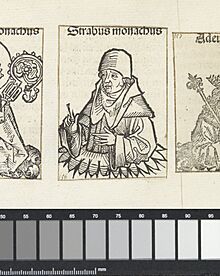Walafrid Strabo facts for kids
Quick facts for kids
Strabo
|
|
|---|---|

Еngraving of Strabo by Wilhelm Pleydenwurff, Nuremberg, 1493
|
|
| Born | c. 808 Swabia
|
| Died | 18 August 849 Reichenau
|
| Occupation |
|
Walafrid (also spelled Walahfrid), known as Strabo (meaning "squint-eyed"), was an important Benedictine monk and writer. He lived from about 808 to 849 on Reichenau Island in southern Germany. He wrote many books about religion, history, and poetry.
Contents
Life of Walafrid Strabo
Walafrid Strabo was born around 805 in a place called Swabia. He started his education at Reichenau Abbey, which was a monastery. His teachers there included Tatto and Wetti. Walafrid even wrote a poem about Wetti's visions.
Later, he went to the monastery of Fulda to study more. There, he learned from a famous scholar named Rabanus Maurus. After his studies, Walafrid returned to Reichenau. In 838, he became the abbot, which is the head of the monastery.
For a short time, Walafrid was forced to leave Reichenau. This happened because he supported Lothair I after his father, Louis the Pious, died in 840. Walafrid had been a teacher to Lothair's younger brother, Charles the Bald. But he chose to side with Lothair in a family disagreement.
However, Walafrid was allowed to return to his monastery in 842. He died in 849 while on a trip to visit his former student, Charles the Bald. His friend and former teacher, Rabanus Maurus, wrote a poem praising Walafrid after his death.
Walafrid's Writings
Walafrid Strabo wrote many different kinds of works. These included books about religion, history, and poems.
Religious Writings
Walafrid wrote about the first 20 psalms from the Bible. He also summarized a longer commentary on the book of Leviticus by his teacher, Rabanus Maurus. Some people also believe he wrote a book explaining the four Gospels.
De exordiis et incrementis
One of his important religious books is called De exordiis et incrementis quarundam in observationibus ecclesiasticis rerum. He wrote this book between 840 and 842 for a librarian named Reginbert of Reichenau.
This book has 32 chapters. It talks about many church customs and items. These include churches, altars, prayers, bells, pictures, baptism, and the Holy Communion. Walafrid even included German words for some of the things he described. He said that Solomon had animals like monkeys and peacocks at his court, so he could also include different words in his writing.
On the Holy Mass
In his explanation of the Mass, Walafrid did not get involved in the big debates of his time. He simply explained that Jesus gave his followers the sacraments of his Body and Blood. He said Jesus used bread and wine for this, which were very fitting symbols. He taught his followers to celebrate these as a way to remember his suffering and death. Walafrid clearly stated that the Eucharist is "truly the body and blood of the Lord."
In the last part of this book, Walafrid described how society works. He used ideas from Saint Paul to show that everyone has a role. He compared society to a body, where each part is important and works together. He believed that people in public roles should feel responsible for society as a whole.
History and Poetry
Walafrid also wrote important historical works and many poems.
Historical Works
His main historical works include a rhyming story called Vita sancti Galli. This book tells the life of Saint Gall. Even though it was written almost 200 years after Saint Gall died, it is still a key source of information about his life. Walafrid also wrote a shorter story about Saint Othmar, who was an abbot of St. Gall and died in 759.
Poetical Works
Walafrid's poems include a short story about Saint Blathmac. Blathmac was a monk from Iona who was killed by the Danes in the early 800s. He also wrote about Saint Mammes and a poem called Liber de visionibus Wettini. This last poem was written in a special style called hexameter. It was based on a story by Haito, who was an abbot of Reichenau. Walafrid dedicated this poem to Grimald, who was Wetti's brother and Walafrid's teacher.
Many of Walafrid's other poems are short messages to kings, queens, and friends. He wrote to people like Lothair I, Charles, Louis, Pippin, Judith, Einhard, Grimald, Rabanus Maurus, and others.
Hortulus
His most famous poem is Liber de cultura hortorum, which is often called the Hortulus. This poem is about a small garden on Reichenau Island that Walafrid took care of himself. It describes the different herbs he grew there and what they were used for, like medicine. Sage is given a special place, followed by rue (which was thought to be an antidote to poisons). He also wrote about melons, fennel, lilies, poppies, and many other plants. The poem ends with the rose, which he called "the flower of flowers" because of its beauty and scent.
De Imagine Tetrici
The poem De Imagine Tetrici is written as a conversation. It was inspired by a statue of an emperor on horseback. People believed this statue showed Theodoric the Great. It stood in front of Charlemagne's palace in Aachen.
Walafrid may have also owned a personal prayer book, called a breviarium. This book, known as Codex Sangallensis 878, might have been started when he was a student at Fulda.
Works Incorrectly Attributed to Walafrid
For a long time, people thought Walafrid wrote the Glossa Ordinaria, which is a collection of notes on the Bible. This idea came from Johannes Trithemius, an abbot who lived much later (1462–1516). However, we now know that the Glossa Ordinaria was actually written in the 12th century, long after Walafrid lived. It is now believed to be the work of Anselm of Laon and his students.
See also
 In Spanish: Walafrido Strabo para niños
In Spanish: Walafrido Strabo para niños

